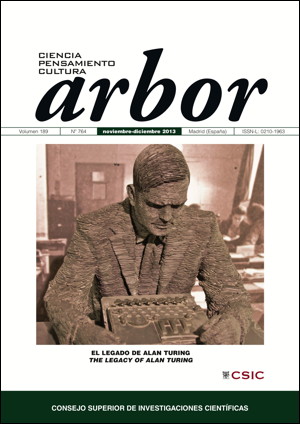Today’s zombie myth: collective sacrificial dismemberment
DOI:
https://doi.org/10.3989/arbor.2013.764n6012Keywords:
Analytical psychology, myth, zombie, symbol, apocalypseAbstract
For several decades the zombie myth maintained the same symbolic structure as literature and cinematography regarding the perverse use of animal magnetism and hypnosis, the genealogy from which it descends. In the last third of twentieth century the myth underwent a profound transformation, which nevertheless represented a continuation of its previous unconscious meaning. The analysis of the new archetypal elements that it included, closely related to a nuclear aspect of the spirit of twentieth century art, enables us to develop an interpretive approach to a mythical framework and its underlying psychological process currently running through the collective psyche: respectively, the initiation death and the solvent and disintegrative dynamic of the soul. It will be based in the analytical psychology theoretical framework and we will use the historical-comparative method.
Downloads
References
Brooks, M. (2006). World War Z: An Oral History of the Zombie War. New York: Crown Publishers.
Carcavilla, L. (2012). "Genealogía hipnótica del mito del zombi: Estructura arquetípica". Revista internacional de Humanidades Médicas, 1, 1, pp. 83-105. Recuperado de http://humanidadesmedicas.com/_uploads/Rev_Int_Hum_Med_Vol_1_N%C2%BA_1_2012_Baja_res.pdf
Carcavilla, L. (2013a). "Genealogía hipnótica del mito del zombi: The Magic Island (1929)". Asclepio, 65 (1), p003. 2013.03 http://dx.doi.org/10.3989/asclepio.2013.03
Carcavilla, L. (2013b). "Genealogía hipnótica del mito del zombi: White Zombie (1932)". Escritura e Imagen, Vol. 9 (2013), pp. 127-154. Recuperado de http://revistas.ucm.es/index.php/ESIM/article/view/43541
Deleuze, G.; Guattari, F. (1972). El Antiedipo. Capitalismo y esquizofrenia. Barcelona: Barral Editores.
Eliade, M. (1975). Iniciaciones místicas. Madrid: Taurus.
Eliade, M. (1991). Mito y realidad. Barcelona: Labor.
Eliade, M. (1996). El chamanismo y las técnicas arcaicas del éxtasis. México D. F.: Fondo de Cultura Económica.
Eliade, M. (2001). Herreros y alquimistas. Madrid: Alianza. Eliade, M. (2003). El mito del eterno retorno. Madrid: Alianza.
Eliade, M. (2005). Mitos, sue-os y misterios. Barcelona: Kairós.
Ellenberger, H. F. (1976). El descubrimiento del inconsciente. Historia y evolución de la psiquiatría dinámica. Madrid: Gredos.
Fernández Gonzalo, J. (2011). Filosofía zombi. Barcelona: Anagrama.
Ferrero, A.; Roas, S. (2011). "El 'zombi' como metáfora (contra)cultural". Nómadas. Revista Crítica de Ciencias Sociales y Jurídicas, 32 (4). Recuperado de http:/ /pendientedemigracion. ucm.es/info/nomadas/32/ferrero_roas.pdf http://dx.doi.org/10.5209/rev_NOMA.2011.v32.n4.38076
Freud, S. (1993). Psicopatología de la vida cotidiana. Buenos aires: Amorrortu.
García Bazán, F.; Nante, B. (2005). "Introducción a la edición espa-ola". En Jung, C. G., Psicología y alquimia. O. C. Vol. 12 (pp. IX-XLII). Madrid: Trotta.
Giegerich, W. (2007). Technology and the Soul. From the Nuclear Bomb to the World Wide Web. New Orleans: Spring Journal Books.
Gómez Rivero, A. (2009). Cine Zombi. Madrid: Calamar Ediciones.
Hillman, J. (1987). "Wars, Arms, Rams, Mars: On the Love of War". En Andrews, V.; Bosnak, R.; Walter Goodwin, K. (Ed.), Facing Apocalypse (pp. 118-136). Dallas: Spring Publications.
Hillman, J. (1999). Re-imaginar la psicología. Madrid: Siruela.
Hillman, J. (2004). El sue-o y el inframundo. Barcelona: Paidós. Jung, C. G. (1962). Símbolos de transformación. Buenos Aires: Paidós.
Jung, C. G. (1971). Tipos psicológicos II. Barcelona: Edhasa.
Jung, C. G. (1999). Sobre el fenómeno del espíritu en el arte y en la ciencia. O. C. Vol. 15. Madrid: Trotta.
Jung, C. G. (2001). Civilización en transición. O. C. Vol. 10. Madrid: Trotta.
Jung, C. G. (2002). Mysterium coniunctionis. O. C. Vol. 14. Madrid: Trotta.
Jung, C. G. (2004). La dinámica de lo inconsciente. O. C. Vol. 8. Madrid: Trotta.
Jung, C. G. (2005). Psicología y alquimia. O. C. Vol. 12. Madrid: Trotta.
Jung, C, G, (2006). La práctica de la psicoterapia. O. C. Vol. 16. Madrid: Trotta.
Jung, C. G. (2007). Dos escritos sobre psicología analítica. O. C. Vol. 7. Madrid: Trotta.
Jung, C. G. (2008). Acerca de la psicología de la religión occidental y de la religión oriental. O. C. Vol. 11. Madrid: Trotta.
Kerényi, K. (2006). En el laberinto. Madrid: Siruela. Kirkman, R.; Adlar, C.; Rathburn, C.; Moore, T. (2003-) . The Walking Dead. California: Image Comics.
Korstanje, M. E. (2009). "El culto a los muertos: la mitología nórdica antigua en el cine moderno". Revista Chilena de antropología visual, 13, pp. 61-78. Recuperado de http://www.antropologiavisual.cl/korstanje.htm
Lacan, J. (2004). El Yo en la Teoría de Freud y en la Técnica Psicoanalítica. Buenos Aires: Paidós.
Martínez Lucena, J. (2008). "Hermenéutica de la narrativa del no-muerto: Frankenstein, Hyde, Drácula y el zombi". Pensamiento y Cultura, 11 (2). Recuperado de http://pensamientoycultura.unisabana.edu.co/index.php/pyc/rt/printerFriendly/1207/1760
Martínez Lucena, J. (2010). Vampiros y zombis posmodernos. La revolución de los hijos de la muerte. Barcelona: Gedisa.
Martínez Lucena, J. (2012). Ensayo Z. Una antropología de la carne perecedera. Córdoba: Berenice.
Martínez Lucena, J.; Barraycoa, J. (2012). "El zombi y el totalitarismo: de Hannah Arendt a la teoría de los imaginarios". Imagonautas, 2 (2), pp. 97-108. Recuperado de http://imagonautas.gceis.net/sites/imagonautas.gceis.net/files/images/6.-_martinez_y_barraycoa.pdf
Palacios, J. (Ed.) (2010). La plaga de los zombis y otras historias de muertos vivientes. Madrid: Valdemar.
Roob, A. (2005). El museo hermético. Alquimia y mística. Köln: Taschen.
Published
How to Cite
Issue
Section
License
Copyright (c) 2013 Consejo Superior de Investigaciones Científicas (CSIC)

This work is licensed under a Creative Commons Attribution 4.0 International License.
© CSIC. Manuscripts published in both the printed and online versions of this Journal are the property of Consejo Superior de Investigaciones Científicas, and quoting this source is a requirement for any partial or full reproduction.All contents of this electronic edition, except where otherwise noted, are distributed under a “Creative Commons Attribution 4.0 International” (CC BY 4.0) License. You may read here the basic information and the legal text of the license. The indication of the CC BY 4.0 License must be expressly stated in this way when necessary.
Self-archiving in repositories, personal webpages or similar, of any version other than the published by the Editor, is not allowed.














